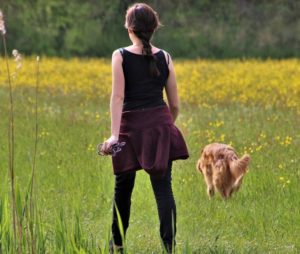One of the best ways to spend time with your dog is connecting with them on a walk. This gives you as the owner time to breathe and take a break from the daily grind. This also allows your dog to embrace a change in scenery from the house that they have been kept up in. Taking a simple and occasional walk will allow the both of you to walk in some freedom while spending quality time with one another.
The Proof is in their Actions

What Does Misbehaving Look Like?
There are some actions that a dog will partake in that will make it obvious that they are misbehaving. If they begin to bite others that surround them, there is no doubt that they are not being well-mannered. There are some less obvious signs that will reveal that your dog could use some fine tuning when it comes to their actions. While tugging on their leash could be a sign of misbehavior, it could also be a sign that the owner needs to retrain their dog in certain areas. If you find your dog regularly tugging on their leash while going for a walk, there are definite steps that you can take to prevent this from happening.
A dog doesn’t have to act on a big level in order to be considered as misbehaving. On the other hand, a dog that tugs on his leash when he sees another dog doesn’t have to be deemed as a disobedient dog. Still, it is still a problem that can be fixed through some redirecting. If this has been a habit for your dog for quite some time, there is a good chance that it can be fixed. It will take persistence and patience, but the results will prove to be worth your time.
Small, Simple Steps
Don’t Forget to Reward
When you are raising a child in a certain area, you must do more than just tell them to do what you want them to do with authority. This might work for a short amount of time but eventually they will want something more than the fear and respect of your voice to motivate them. In the same way that children enjoy and adhere well to outside incentives, dogs respond well when they are given items that serve as motivation. Different incentives might work differently for each dog. Most dogs will respond well to a sweet treat. Make sure that you hand them their treat as soon as they accomplish what you have expected of them. When you give it to them in as soon as they have been obedient, they will understand that the reward has come as a result of their good behavior. If you wait too long before rewarding them, this may cause some confusion as to why they have received a reward. Persistence throughout this process will pay off. When your dog can connect their good behavior with beneficial consequences, it will create a momentum for your dog to be able to continue being well trained. Before you know it, you will be able to take a leisurely walk without your dog tugging on the leash.

Different Type of Rewards
Practice with the Pup
As with any type of experience that you want to improve upon, it will take a decent amount of time to practice. Before you take your dog out on a “real” walk, practice proper walking manners in the comfort of your own backyard. In order to practice for the real deal, you will want to put your dog on a leash as if you were going on an actual, lengthy walk. Use short, precise commands to let your dog know when you want them to stay and when you want them to move. Giving too long or wordy of a commandment might allow your dog to become confused.
What if my Dog is Older?
Perhaps your dog is getting up there in years and has taken on some less than desirable traits or maybe you adopted an older dog that has taken on many characteristics before they came into your care. Either way, the exciting news is that old dogs can learn new tricks. There is hope that old patterns can be broken, and new ones can be formed.
Before you even take out your elderly dog for a walk, you will want to think about the type of leash that you will use in order to walk them with. By choosing a shorter leash, you be able to keep your dog closer to you as you two are on your walk. In this way, if the need to correct a behavior arises, you can do so before your dog travels too far ahead of you.
Having Influence over their Demeanor
Sometimes a dog’s misbehavior arises not necessarily as a result of rebellion but more as a result of becoming overly excited. If your dog becomes unbearably excited at the sight of a leash, condition them to see it as a normal, everyday object by having them wear it inside. While you cannot completely change the temperament of your dog, you can influence them to act in a certain way.
There are only certain dogs that have a rebellious streak only when they feel something restricting them. This is a phenomenon that is not uncommon to well-behaved dogs. These types of dogs typically only feel compelled to become aggressive or protective when there is something standing between your dog and another one. In the same way that you can’t easily go from driving one mile per hour to one hundred miles per hour in a few seconds, you can’t expect to fully train a dog within a few minutes. Especially if habits have already been formed, they are going to take some time to break so that they can have the capacity to form into new habits.
Think Positive
Correction can Take Place in the Details
As you are working on training your dog to become oblivious to other dogs, you will need to keep in mind what size of leash you want to work with. While using a shorter leash can immediately correct unwanted behavior for some dogs, for others it can create a certain amount of tension. Some dogs can be easily provoked by having their owner so close by while attempting to correct their behavior. This can sometimes promote the behavior rather than eliminate it. If your dog is easily provoked to misbehavior by the sight of another dog, a longer leash may be preferable for the two of you. Practice with whatever length leash you believe will work best for you and your dog. After they have grown accustomed to remaining docile while coming across other dogs, you can begin to have them follow you by having them obey short commands. When you convince them to follow you based off short commands, longer walks will become easier for the two of you.
Don’t Despise Humble Beginnings
Challenge them with Longer Walks
After your dog has already been obedient in the process of following short, concise commands, seek to give out more complicated commands that may take more skill for them to follow. Consider walking with them for a period in one direction and then stopping and turning around so that they now must follow you while walking in the opposite direction. If you can help them to follow more complex directions that expand beyond the realm of just one-word commands, they can have the capacity to listen on a deeper level. The better that your dog listens in general, the better chance they have of maintaining good behavior while going on a walk with you. Even when your dog becomes better at following commands, there is no guarantee that any misbehavior that had been occurring will stop. However, by having a dog that is better at listening to commands, you will be able to easily correct behavior on the spot rather than letting it continue for so long that it ends up becoming a problem.
Other Things to Consider
It was mentioned earlier that devices can be used to aid with the discipline of walking your dog. Instead of using a regular leash and collar, you may want to use a harness. In the same way that you will want to think about the length of the leash before heading out on a walk with your dog, you will also want to consider what type of device you are using. Consider how your dog reacts to it and whether they adhere well to it. If the harness or leash proves to be bothersome to your dog, then you will want to find something that fits your dog properly.

Leash Length is Important
While every dog reacts differently to the length of the leash being used on them, it is generally a better idea to start off with a shorter leash. This will allow your dog to remain close by as the two of you are going for a walk, which works out well for a couple different reasons. When the leash that you are using is shorter, you can keep your dog close by and watch their good behavior as well as their misbehaviors. If you see their actions immediately, you can correct it before it becomes a major mishap. On the other hand, you won’t want to be constantly watching their behavior to the point where it becomes a nuisance. As soon as you see that your dog is listening well while being on a shorter leash, get a little bit longer of a leash to try out on your dog. Remember to be consistent with rewarding your dog when the time to do so comes.
Use the Authority that you Have
Your Attitude has Power
As you have probably realized, the methods being used are used in a positive light. If possible, only use positive avenues for correcting your dog’s behavior. This will work as a more effective method than using a negative form of punishment, such as scolding them or pulling back on the leash when they pull. Along with having positive practices stowed away for you to bring out when needed, you should have a positive mindset. This will rub off on your dog’s ability to walk appropriately. If you have an inspiring mindset when it comes to walking your dog, the process will go more smoothly. If you have a pessimistic outlook on how the process of training your dog to behave well will go, you will find yourself butting heads with your dog quite often. Thoughts are powerful. They affect the people that surround you as well as the furry friends that follow us.
One of the reasons why some dogs walk neatly next to their owners is because their focus is on them, almost at the exclusion to their surroundings. If you want your dog’s focus to be on you while you two are going on a walk, you will have to invest some time into the journey of training your dog. Rewards will be highly effective for the training process, especially in the beginning portion of it. Just as physical items can serve as a great reward and motivator for dogs, verbal cues can compel dogs to move in the direction that you want them to. Dogs respond well to exaggerated facial expressions along with positive words. Train your dog in small increments as opposed to training your dog while you are on a long-winded walk with them. Practicing in the backyard is a good place to start. You are within the confines of your own space. It is the perfect place to practice listening skills with your dog. If they listen well and only need a few areas to be fine-tuned. However, if they are new to being trained to walk appropriately, it may take a few tries for them to sanction their actions.
Younger Pups
If you have a puppy, then you already have a sort of an advantage over those who have had their dogs for quite some time. With a younger pup, you have more of a blank slate to work with. Especially with a little puppy, it is a good idea to allow them to be comfortable with wearing a collar before you head outside on your walk. When they become comfortable with wearing a collar, they will have a lower chance of becoming anxious by having it on. While you begin the process of allowing your dog to wear their collar indoors, be sure to reward them with treats. The association that will begin to take place between you and your dog wearing their collar will be a positive one.
After your pup comes to expect a treat with the special phrase that you have chosen, you can allow them to come to you and then follow you for a few steps. The key to training your dog is to challenge them to walk further then they normally would without tiring them out. If you walk too far away from them and they follow you without receiving a treat, they may feel as though you are teasing them. If you give your dog a treat too soon, they might not understand what they are receiving a treat for. As you master the timing for giving your dog a treat, they will better be able to master their behavior.
Allow Patience to Accompany the Process
Just as you will want to work in small increments when you are rewarding your puppy during training, you will want to start off small when you are taking them on an actual walk. You can’t jump into taking them on an incredibly long walk right after training and expect everything to run smoothly. Small walks outdoors will allow for a smooth transition to take place from their session of training to the true outdoors. One of the best ways to correct behavior is by taking preventative measures. Based on how long you have known your dog for, you can tell when they have an anxious look in their eyes- the kind of look that longs to participate in some type of misbehavior. Instead of tugging on their leash before they do, lure them away from the possibility of misbehaving by calling out to them. Let them know that you have a special treat and then have them follow you in the direction that you wish for them to go. After they listen, reward them for their behavior and shower them with your full attention. If you follow these steps consistently, your dog will effortlessly set the example for those that surround the two of you.
Time is a Factor
Don’t grow weary if it seems like your dog is taking longer than expected to take proper walks. You may need to adjust your expectations so that they are more suitable for what your dog is able to accomplish. This adjustment may have to take place depending on your dog’s temperament and age. Whether your dog catches on right away or they are taking their time to learn not to tug on their leash, remember to take moments to appreciate your dog for who they are.
There is not much that should limit your hope that you have when it comes to training your dog. If your dog is elderly, it is not too late to retrain their behavior as well as their way of thinking. Part of their behavior will improve if they are focused on their owner rather than on distractions. While you cannot get rid of distractions that surround you and your dog when you go for a walk, you can improve their focus so that they will be less prone to responding to distractions.
![12 Best Dog Foods for Toy Breeds [Buyer's Guide] 12 Best Dog Foods for Toy Breeds [Buyer's Guide]](https://shihtzuexpert.com/wp-content/uploads/2019/05/3-5.jpg)


![Best Cheap Dog Foods - our Top 10 Picks of High Quality Brands That Are Still Affordable [Under $1 per pound!] in 2023 Best Cheap Dog Foods - our Top 10 Picks of High Quality Brands That Are Still Affordable [Under $1 per pound!] in 2023](https://shihtzuexpert.com/wp-content/uploads/2018/01/Best-Cheap-Dog-Food-Featured-image.png)

